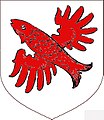Arnshaugk Castle
| Arnshaugk Castle | ||
|---|---|---|
|
Stadt Neustadt / Orla, copper engraving by Merian 1650, in the background of the town you can see Arnshaugk Castle, here titled "Schloß Arnsburg" |
||
| Creation time : | 12th to 13th centuries | |
| Castle type : | Höhenburg, spur location | |
| Conservation status: | Parts of the outer bailey | |
| Standing position : | Count | |
| Place: | Neustadt an der Orla | |
| Geographical location | 50 ° 43 '45.1 " N , 11 ° 44' 54.6" E | |
|
|
||
The Arnshaugk Castle (Adlerhorst) was a strategically important point in the Orlaggebiet and the center of the medieval dominion Arnshaugk in Orlagau . Otto von Lobdeburg-Arnshaugk, a line of the free lords of Lobdeburg near Jena, named itself after the castle in the middle of the 13th century .
location
The spur castle was located on a mountain spur protruding to the west in the southwest of today's urban area of Neustadt an der Orla in the Saale-Orla district in Thuringia .
Today there are only various farm buildings in the eastern area of the former outer bailey , which, according to previous dendrochronological research results, essentially date from the 16th and 17th centuries. Century (1517d, 1592d, 1615d). The last building of the main castle appears to have been due to the collapse of the keep demolished quickly: "... on the first of August, 1700, the tower is zusammengerutschet in glorious sunshine in it ...." On a watercolor by YES Zwaad from 1721 can you can still see a remnant of a palatial building with window openings on an elevation. Another illustration of Arnshaugk Castle can be found on the Merian engraving "Neustadt an der Orla" from 1650 in the background. The castle is called here as Arnsburg Castle .
history
The assumption of a fortified complex as an early seat of power in an area dominated by the Slavic population before the 12th / 13th centuries. Century is likely on the mountain spur, but so far cannot be documented or archaeologically proven. The builders of the late medieval castle were with some certainty the lords of Lobdeburg, who temporarily resided at the castle from the middle of the 13th century (Otto von Lobdeburg-Arnshaugk's presence is made clear several times by notifications at his castle in Schleiz). In all the documents that have been handed down, the Lobdeburgers always appear as “free masters”. Already in December 1289 or in January 1290 at the latest the Arnshaugk line of the Lobdeburger expired, since both male heirs (Otto and his son Hartman) never appeared again in documents from this time on. Apparently both died at the same time during a military conflict (they appeared several times in the company of Dietrich von Landsberg). The Benedictine monastery in Auhausen was the ancestral monastery of the Lobdeburgers in the family's original Franconian region of origin. After they settled in Thuringia (Barbarossa had enfeoffed the Franconian settlers there with land; first mention of a Herr von Auhausen in 1133 in the Romanesque Lobdeburg above Lobeda near Jena), they founded the Cistercian convent in Stadtroda as a new burial place. The widow Elisabeth von Lobdeburg-Arnshaugk, presumably a born Countess of Orlamünde, (* around 1262 - † August 22, 1331 in Eisenach) brought the possessions of the Lobdeburg-Arnshaugk line at the wedding with the Landgrave of Thuringia , Albrecht II the Degenerate to join the marriage. The son of Albrecht, Friedrich I the bitten , married the heir daughter Elisabeth von Arnshaugk in 1300 (according to legend in the Reinhardsbrunn monastery ).
When Saxony was divided in 1485, Arnshaugk remained with the Ernestine line . In 1567, as a result of the Grumbachian Handel after the execution of the Reich against Duke Johann Friedrich II., It was transferred to the Albertinian line as security , was completely ceded to this in 1660 and formed the Arnshaugk office in the Neustadt district until 1815 . Because of the ruinous condition of the castle, the seat of the office had been moved to the town of Neustadt an der Orla since the 16th century . From 1788 the offices of Arnshaugk and Ziegenrück were, so to speak, taken care of in personal union by the same officials. After the partition of Saxony in 1815, Arnshaugk came with most of the office to Saxony-Weimar-Eisenach .
coat of arms
Blazon : "Split of silver and red, inside an inclined left bar in mistaken tinctures ." And "In red a slanting silver winged fish."
Coat of arms of those of Lobdeburg
literature
- Paul Lehfeldt : Architectural and Art Monuments of Thuringia. Department 1: Grand Duchy of Saxony-Weimar-Eisenach. Volume 5 = H. 24/25: Neustadt administrative district. District court districts Neustadt a. Orla, Auma and Weida. Fischer, Jena 1897, pp. 4-7 .
- Andreas Konopatzki: “Arnshaugk” castle complex near Neustadt ad Orla - a castle and yet not a castle - scientific investigation of a supposed outer castle. In: Hartmut Hofrichter (Red.): The early castle building and its medieval preliminary stages (= research on castles and palaces. Vol. 3). Deutscher Kunstverlag, Munich et al. 1997, ISBN 3-422-06208-4 , pp. 75–80.
- Sebastian Martius: The castle and the office of Arnshaugk: former power and administrative center in Orlagau. In: Home year book of the Saale-Orla-Kreis. Vol. 11, 2003, ZDB -ID 919728-x , pp. 81-84.
- Rudolf Großkopf: The Lords of Lobdeburg , 1925
- Beate Tomaschek, Klaus P. Wittwar, Andreas Konopatzki u. Anette Weber: Building research , Friedrich Otto University Bamberg, 1994
See also
- List of German noble families
- Gotha Mint, Groschenzeit - hollow penny of the widow of Frederick I (1307–1323), Elisabeth von Arnshaugk



